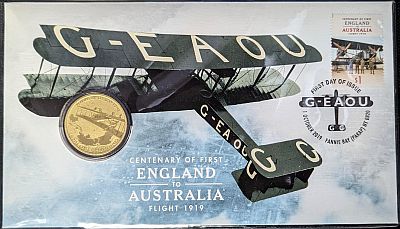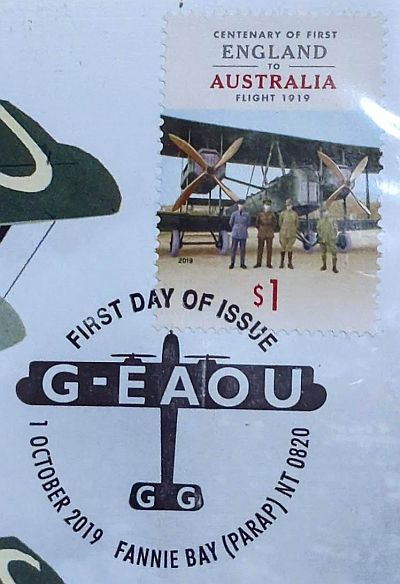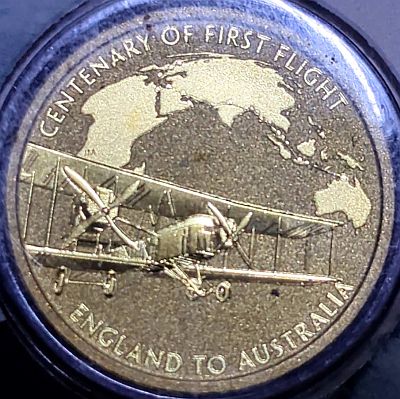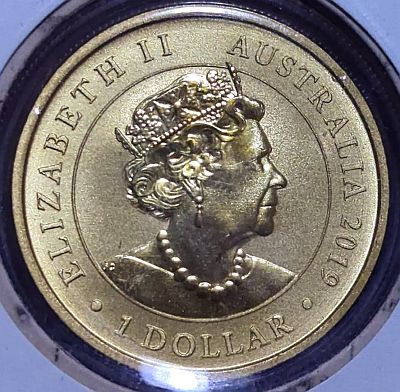A great use of the PNC envelope to show the subject

In 1903 the Wright brothers famously flew. Although not the first flight, or even the first aeroplane flight, it was the first photograph of one – proving that pics or it didn’t happen isn’t a new phenomena.
Within about a decade, by around 1914, commercial aviation was born. Just five years later, the first flight from England to Australia occurred. No small feat, given the vast distance involved – 17,910 kilometres (11,128 miles). The endeavour was spurred along by the Australian government, who offered £10,000 to the first Australian to fly from England to Australia within 30 days.
As depicted on this 2019 Postal Numismatic Cover by Australia Post (and the accompanying non-circulating dollar coin), the winning aircraft was a twin-engine, Vickers Vimy heavy bomber. Developed during the latter stages of World War I, only a handful had entered service before the 11 November 1918 Armistice. The plane went on to serve throughout the 1920s in both military and civilian capacity. The Airways museum has some good photos of the plane we are looking at, G-AEOU.
One thing I quite like about this PNC is the way it takes the central element of the theme – the specific plane involved, and gives a good view of it from several angles – between the envelope, the coin, the stamp and the cancellation mark.
The reverse of the PNC itself shows a view of the plane coming in to land, and details of the depicted event:
“In early 1919, the Australian government offered £10,000 to the first Australian to fly from England to Australia within 30 days. Highly decorated pilot and World War I veteran Captain Ross Smith took up the challenge, alongside his brother, Lieutenant Keith Smith, navigator and assistant pilot, as well as mechanics Sergeants Walter Shiers and James Bennett. The Vickers Aircraft Company assisted by making available its newly developed, twin-engine Vimy heavy bomber aircraft and by establishing landing fields and fuel depots along the route. Ross Smith and crew successfully completed the record-setting journey in just under 28 days, landing in Australia on 10 December 1919. The men were hailed as heroes in Australia and internationally.”

The stamp gives an indication of the size of the craft in relation to the crew. The cancellation mark is from Fannie Bay, a suburb of Darwin, Northern Territory. The first place the plane touched down in Australia before going on to Melbourne. The PNC was limited to 7,000 copies, with an issue price of $17.95.
The Vickers Vimy aircraft itself had a top speed of 177 km/h (110mph). It had an open cockpit and maps more designed for sea travel than air. The pilot’s navigation was excellent although the journey must have been quite arduous. Various relics of the trip survive, including a pickle jar they used to drop a message to HMAS Sydney – which was positioned in the Timor Sea off Darwin to guide them in case of need.

Coins in PNCs are in a plastic holder, but not necessarily tightly secured in place, or guaranteed to be facing the right way up. My example has the coin upside down in the holder.

Produced by the Perth Mint, the coin features a slightly modified version of the Jody Clarke portrait (Used 2019 – 2023) with the value on the obverse as well as the monarch, country and year. Although the Perth Mint is an official Australian Government entity, it only produces non-circulating coins. The last circulating Australian coins produced by the Perth Mint were (some of) the first portrait 2c coin between 1966 – 1984.
I was travelling myself this week, and thought of this PNC watching Qantas in-flight safety video. It reminisces through the history of that airline – which started just after the Smith’s record-breaking flight. That video starts with an Avro 504 bi-plane, similar vintage to the Vickers, it was produced from 1913 – 1932. The Qantas museum has a lot of interesting information about the history of commercial flight and some of the innovations, including the first fully enclosed passenger cabins in the 1930s.
Coming back to the original topic, there is a picture of the Lockheed 1049 Super Constellation which operated “the Kangaroo route” from 1947 – 1955. This was “the first aircraft that enabled Qantas to establish and sustain long-range overseas air service in its own right and it was the longest air service in the world using the same aircraft all the way. Constellations were the first Qantas aircraft to feature flight hostesses (female cabin crew) and be pressurised. Qantas Super Constellations operated the first ever regular round-the-world air service via both hemispheres in 1958.”
That wasn’t actually the first commercial flight between England and Australia. In 1935, Qantas offered a service which would get you between the two countries. It took 12 days and 31 stopovers, using multiple different aircraft. There was no cabin crew, but the co-pilot would bring you sandwiches.
Air travel has come a long way!


Leave a Reply